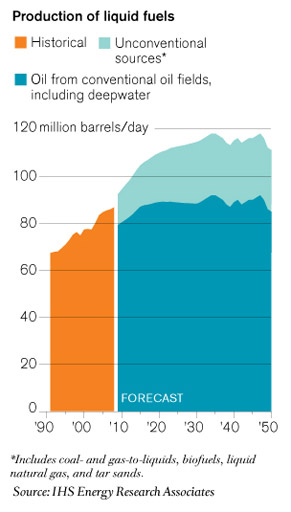The End of Easy Oil

The world won’t run short of petroleum in the next few decades, but there’s a limited supply of easy-to-reach oil. Between now and 2030, production from such “conventional” sources will barely rise–from 79 million to 85 million barrels per day.
During the same period, demand for liquid fuels is expected to rise from 86 million to 106 million barrels per day. While more than half of that extra demand will be met by other sources, such as biofuels and fuels derived from coal or natural gas, the petroleum industry will have to make up the rest from harder-to-extract oil supplies.
To get at this oil, companies will drill in deep waters to tap reserves below the ocean floor. By 2030, the production of oil from waters deeper than 600 meters will increase from five million to 10 million barrels per day. This year’s disaster in the Gulf of Mexico–where BP was drilling at a depth of 1,500 meters–highlights the risks involved.

And petroleum companies will increasingly turn to unconventional sources such as tar sands. The largest of these molasses-like deposits are in Canada and Venezuela, whose combined resources of this type are believed to exceed the total world resources held in conventional oil fields. Production from these areas is projected to rise from 2.3 million barrels per day at present to 5.5 million barrels per day in 2030, according to a study by Cambridge Energy Research Associates, an energy consultancy.
That increase will meet about 16 percent of the total demand, but at the cost of a disproportionate environmental impact. It takes huge amounts of energy to extract and process tar sands, generating two to four times the greenhouse gases associated with conventional petroleum production.
As oil gets harder to find, prices may rise, which will make riskier exploration more worthwhile and also boost alternatives, including advanced biofuels. But a price on carbon emissions could change the calculus, making tar sands particularly uneconomical.
Keep Reading
Most Popular
Large language models can do jaw-dropping things. But nobody knows exactly why.
And that's a problem. Figuring it out is one of the biggest scientific puzzles of our time and a crucial step towards controlling more powerful future models.
The problem with plug-in hybrids? Their drivers.
Plug-in hybrids are often sold as a transition to EVs, but new data from Europe shows we’re still underestimating the emissions they produce.
Google DeepMind’s new generative model makes Super Mario–like games from scratch
Genie learns how to control games by watching hours and hours of video. It could help train next-gen robots too.
How scientists traced a mysterious covid case back to six toilets
When wastewater surveillance turns into a hunt for a single infected individual, the ethics get tricky.
Stay connected
Get the latest updates from
MIT Technology Review
Discover special offers, top stories, upcoming events, and more.